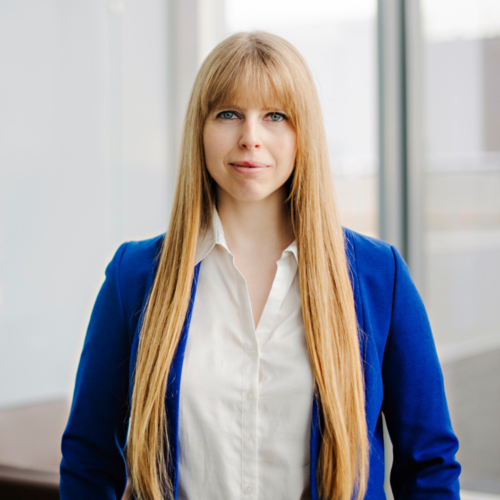
The next big computing evolution
Researcher Christine Muschik thinks outside the box with quantum computing innovations

Researcher Christine Muschik thinks outside the box with quantum computing innovations
By Rose Simone University Relations
Christine Muschik
Professor, Faculty of Science
> Institute of Quantum Computing
> Perimeter Institute
Computing evolutions of the past few decades have already taken us from floppy discs to an era of almost instantaneous communication in an internet-connected world.
But quantum computers promise “an even bigger transformation,” says Christine Muschik, a physics and astronomy professor and member of the University of Waterloo’s Institute for Quantum Computing.
“You could simulate, for instance, new materials,” Muschik says. “You could develop better fertilizers. You could come up with new ways to remove carbon dioxide from the atmosphere. You could design new drugs.”
Even the present-day supercomputers have their limits. They process information in the form of zeros or ones, one line at a time. This means that no matter how big or how powerful they are, some simulations are so complex they can’t be done with classical computers.
But nature has an amazing computing superpower. It is called superposition, whereby information can be grasped in more than one state at the same time. (For example, the spin of a particle can be up and down at the same time.) “The classical computer runs out of steam and out of memory in keeping track of all the combinations, but nature does it effortlessly,” Muschik says.
Being able to build computers to harness this quantum superpower is a long-standing dream of physicists. Even 40 years ago, long before quantum computers were a possibility, the famous physicist Richard Feynman said “nature isn't classical … if you want to make a simulation of nature, you'd better make it quantum mechanical.”
That’s what Muschik is working on. She wants quantum computers that can solve interesting problems, such as simulating quantum interactions, biochemical interactions, processes inside a neutron star or the early moments of the universe.
The technology is getting there. In 2019, Google scientists announced they had achieved “quantum supremacy” by solving a problem on a quantum computer that a classical computer could not solve. But it was a very narrow, specific problem. Getting a quantum computer to do something more complex is difficult.
Muschik explains that in regular computers, there is a lot of error correction going on, as the bits of ones and zeros are being processed using the gates on a computer chip. In a quantum computer, correcting errors is possible in principle, but still technically challenging. The experimental quantum computers that exist today are not error-corrected and mistakes get through. “If I have too many quantum gates in my quantum circuit, then so much error accumulates that we see only noise in the computation,” she says.
To solve this problem, Muschik is thinking outside the box. She is reimagining what computing itself could look like. “We are coming up with new methods for scientific computing,” she says.
Muschik is internationally recognized for her creative research. She received a 2019 Alfred P. Sloan Research Fellow in Physics, given to early-career scientists of outstanding promise. She is still one of few women in the field, although she says women are getting much more support now.
Muschik’s group has achieved some remarkable successes. Most recently, they performed the first-ever simulation of baryons — the particles that make up the matter that surrounds us — on a quantum computer.
To achieve this, the group used hybrid computing whereby a classical and a quantum computer are tied together in a kind of feedback loop. The classical computer can be tasked with parts of a problem that it can do easily, and then the quantum computer can take over to do the parts that are too complicated. They pass the problem back and forth to solve it in a resource-efficient way.
“Instead of replacing the existing infrastructure, we can integrate the quantum computer into the existing infrastructure and complement it,” Muschik says.
Muschik’s group has also been working on a completely new method to get around the extremely error-prone quantum gates in hybrid computing. When particles are entangled, the state (such as the spin value) of one particle in the pair can change instantly when a measurement is made on the other particle. Her group has shown that it is possible to do hybrid computing as a series of measurements on these quantum states and then use measurements to do the calculation, without the need for quantum gates.
“The algorithms to do this look really strange because it's a completely different computing concept, but we have shown that it works,” Muschik says. Next, she hopes to team up with an experimental group to further develop this new measurement approach.
“What is very interesting about this field is that there are is so much unexplored territory. There is a lot of room for true innovation and space for new ideas,” she says.

Read more
To deliver on promised benefits, AI must be built to co-operate

Read more
Canada Research Chair Ian Goldberg sees privacy as a precondition for freedom, dignity and autonomy

Read more
Researchers at Waterloo are developing a technique to take MRI capabilities down to the atomic scale
The University of Waterloo acknowledges that much of our work takes place on the traditional territory of the Neutral, Anishinaabeg, and Haudenosaunee peoples. Our main campus is situated on the Haldimand Tract, the land granted to the Six Nations that includes six miles on each side of the Grand River. Our active work toward reconciliation takes place across our campuses through research, learning, teaching, and community building, and is co-ordinated within the Office of Indigenous Relations.